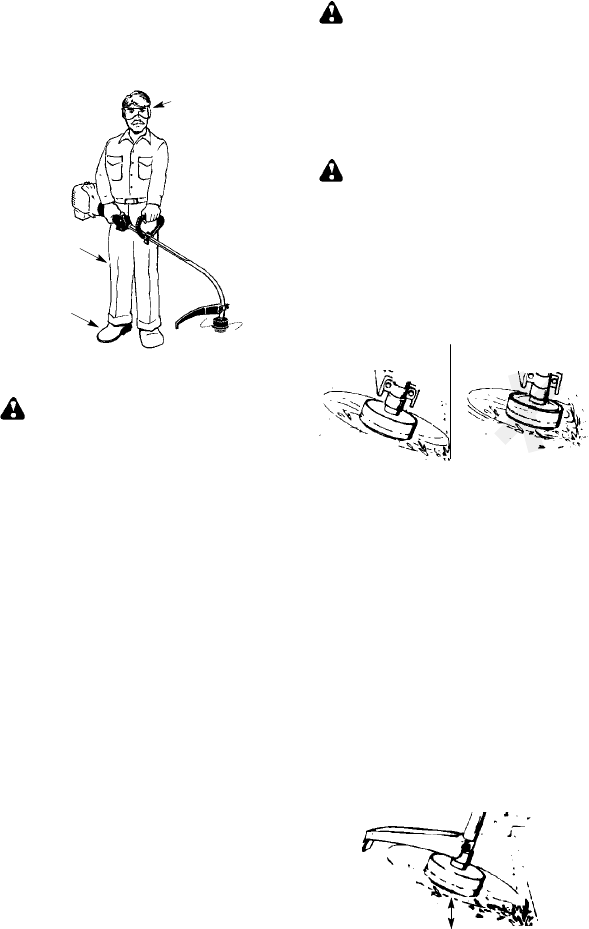
8
OPERATING INSTRUCTIONS
It is recommended that the engine not be
operated for longer than 1 minute at f ull
throttle.
OPERA TING POSITION
Cut from your right to your left.
ALWAYS WEAR:
Eye protection
Long pants
Heavy shoes
WARNING: Alwaysweareyeprotec-
tion. Never lean over the trimmer head.
Rocksordebriscanricochetorbethrowninto
eyes and face and cause blindness or other
serious injury.
Do n ot run the engi ne at a higher speed than
necessary . The cutti ng line wi ll cut efficientl y
when the engine is run at less than full throttle.
At lower speeds, there is less engine noise and
vibration. The cutting line will last longer a ndwill
be less likely to “weld” onto the spool.
Always release the throttle trigger and allow the
engine to return to idle speed when not cutting.
To stop engine:
S Release the throttle trigger.
S Push and hold the STOP switch in the
STOP position until the engine stops.
TRIMMER LINE ADVANCE
Thet rimmerlinewilladvanceapproximately2
inches (5 cm) each time the bottom of the
trimmerheadistappedonthegroundwiththe
engine running at full throttle.
The m ost e fficient line l ength is the maximum
length allowed b y the l ine limiter .Always keep
the shield in place when the tool is being oper-
ated.
To advance line:
S Operate the engine at full throttle.
S Holdthet rimmerheadparalleltoandabove
the grassy a rea.
S Tap the bottom o f the trimmer head lightly
on the ground one time. Approximately 2
inches (5 cm) of line will be advanced with
each tap.
Always tap the trimmer head on a g rassy
area. Tapping on surfaces such as concrete
or asphalt can cause excessive wear to the
trimmer head.
If the line is worn down to 2 inches (5 cm) or
less,more thanonetapwillberequiredtoob-
tain the most efficient line length.
WARNING: Use only 0.080 inch (2
mm) diameterline. Other sizes of linewillnot
advance properly and will result in improper
cutting head function or can cause serious
injury. Do not use other materials such as
wire, string,rope,etc.Wire canbreak offdur-
ing cutting and become a dangerous missile
that can cause serious injury .
CUTTING METHODS
WARNING: Use minimum speed
anddonotcrowdthelinewhencuttingaround
hard objects (rock, gravel, fence posts, e tc.),
whichcandamagethetrimmerhead,become
entangled in the line, or be thrown causing a
serious hazard.
S Thetip of the linedoes thecutting. Yo uwill
achieve t he best performance and mini-
mumlinewearby notcrowdingtheline into
the cutting area. Theright and wrongways
are shown below .
Tip of the Line
Does The Cutting
Right Wrong
Line Crowded Into
Work Area
S The line will easily remove grass and
weedsfromaroundwalls,fences,treesand
flower beds, but it also can cut the tender
bark oftrees or shrubs andscar fences.To
help avoid damage especially t o delicate
vegetation or trees with tender bark,
shorten line to 4--5 inches (10--13 cm) and
use at less t han full throttle.
S For trimming or scalping, use less thanfull
throttle to increase line life and decrease
head wear , especially:
S During light duty cutting.
S Near objects around which the line can
wrap such as small posts, t rees or f ence
wire.
S Form owingorsweeping,usefullthrottlefor
a good clean job.
TRIMMING -- Hold the bottom of the trimmer
headabout 3inches(8 cm)abovetheground
andatanang le.Allowonlythetipofthelineto
make contact. Do not force trimmer line into
work area.
Trimming
3 inches (8 cm)
above ground
SCALPING -- The scalping technique re-
moves unwanted vegetationdown to the
ground. Hold the bottom o f the trimmer head
about 3 inches (8 cm) above the ground and
atanangle.Allowthetipofthelinetostrikethe
groundaroundtrees,posts,monuments,etc.
This technique increases line wear.
















